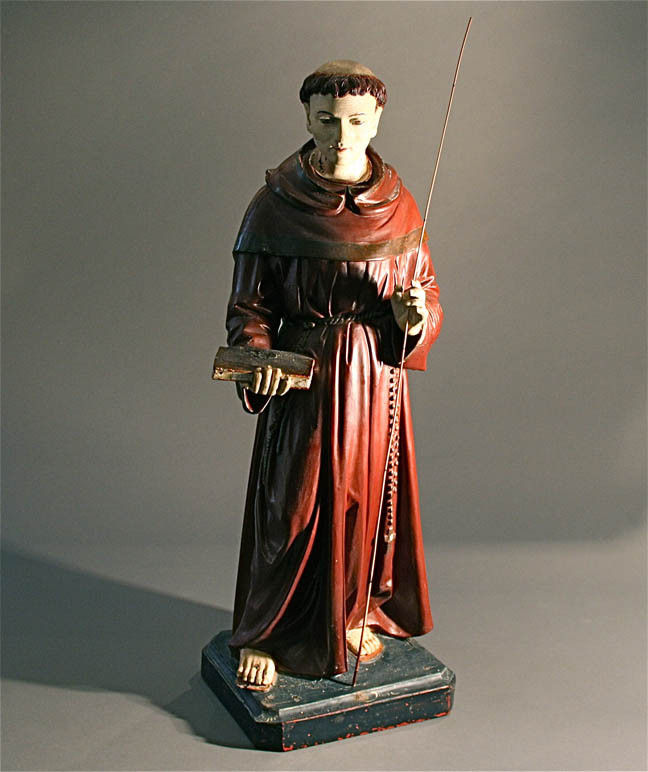

Title: Antique French Saint Anthony Hand-Carved Painted Santo
Shipping: $100.00
Artist: N/A
Period: 18th Century
History: N/A
Origin: N/A
Condition: Museum Quality
Item Date: 1700 to 1800
Item ID: 1788
From 18th Century France, this santo, hand-sculpted from wood and elaborately painted, shows the full body of Saint Anthony, standing. He holds a bible -- the word of God. Saint Anthony is the patron saint of unmarried women and fertility. The figure is intricately carved, with inset glass eyes, wearing a long red robe and carrying a staff. He is displayed on a handsome ebony wood base.
Link: http://en.wikipedia.org/wiki/Anthony_of_Padua
Saint Anthony (August 15, 1195 – June 13, 1231) also venerated as Saint Anthony of Lisbon and Saint Anthony of Padua, is a Catholic saint who was born in Lisbon, Portugal, as Fernando Martins de Bulhões to a wealthy family and who died in Padua, Italy. Anthony was born on the Feast of the Assumption in Lisbon, Portugal. He took the new name of Anthony when he joined the Order of Friars Minor in honor of Saint Anthony the Great, to whom the Franciscan hermitage in the current civil parish of Santo António dos Olivais, Coimbra, where he was living, was dedicated. Anthony joined the Franciscan Order in the year of 1221. Shortly after, Anthony set off to Morocco with another friar. He intended to die preaching the Gospel there. However, upon his arrival in Morocco, he fell so ill he had no choice but to return home.
One day, on the occasion of an ordination, when a great many visiting Dominican monks were present, there was some misunderstanding over who should preach. The Franciscans naturally expected that one of the Dominicans would occupy the pulpit, for they were renowned for their preaching; the Dominicans, on the other hand, had come unprepared, thinking that a Franciscan would be the homilist. In this quandary, the head of the hermitage, who had no one among his own humble friars suitable for the occasion, called upon Anthony, whom he suspected was most qualified, and instructed him to speak whatever the Holy Spirit should put into his mouth. Anthony objected but was overruled, and his sermon created a deep impression. Not only his rich voice and arresting manner, but the entire theme and substance of his discourse and his moving eloquence, held the attention of his hearers. At that point, Anthony was commissioned by Brother Gratian, the minister provincial, to preach the Gospel throughout Lombardy, a region in northern Italy. From then on his skills were used to the utmost by the Church. Occasionally he took another post, as a teacher, for instance, at the universities of Montpellier and Toulouse—both in southern France—but it was as a preacher that Anthony revealed his supreme gift.
In 1226, after attending the Franciscan chapter at Arles, France, and preaching in the French region of Provence, Anthony returned to Italy and served as envoy from the general chapter to Pope Gregory IX. At the papal court, his preaching was hailed as a "jewel case of the Bible" and he was commissioned to produce "Sermons for Feast Days." Anthony was elected minister provincial of the Italian region of Emilia-Romagna on 30 May; the friars held out against the push of Franciscan austerities. Anthony became ill with dropsy and, in 1231, went to the woodland retreat at Camposampiero with two other friars for a respite. There Anthony lived in a cell built for him under the branches of a walnut tree. Saint Anthony died on 13 June 1231 at the Poor Clare convent at Arcella on the way back to Padua at the age of 36. When he died, it is said that the children cried in the streets and that all the bells of the churches rang of their own accord, rung by angels come to earth to honor the death of the saint. He is buried in a chapel (once a church, now enclosed by the current edifice) of the large Basilica of Saint Anthony in Padua. The house where he was born in Lisbon was turned into a church, the Igreja de Santo António de Lisboa.